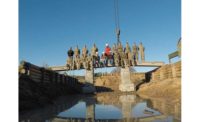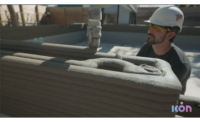A Missouri University of Science and Technology research team has won a $1.4- million U.S. Army Corps of Engineers grant to develop an artificial intelligence program that will determine the best locally-available materials for concrete placed by the agency's established 3D printing methods.
This technology will allow the Corps, owner agency for most infrastructure on navigable U.S. waterways, to quickly 3D-print concrete structures without relying on delivery of large amounts of material via ready-mix trucks and other methods. AI-driven tools such as Concrete.ai and the one being developed for the Corps are rapidly changing the way the building material is delivered. It uses machine learning to optimize mixes that can best take advantage of locally available materials such as aggregates and alternate additives.
"By harnessing the power of AI, our research team aims to streamline the process of material selection, ensuring optimal performance and cost-effectiveness,” says Kamal Khayat, team leader at Missouri S&T in Rolla and university vice chancellor for research and innovation. “The AI program will evaluate a wide range of locally available materials in various areas and identify the most appropriate combinations for 3D printing concrete."
Khayat, also a professor of civil engineering, said using the still-in-development AI tool will enhance efficiency of the construction process, improve troop safety, pave the way for more sustainable practices and help expedite humanitarian assistance missions in the U.S. and abroad. Team researchers have expertise in materials science and engineering, civil engineering and computer science.
According to Khayat, the program could potentially create everything from temporary bridges and barracks to guardhouses and defense obstacles. The Corps has been devoting a large share of its research budget to researching better methods of concrete construction for the last five years, some for use on lock and dam projects but also for U.S. mliitary global use where materials are not always available for missions. The Corps is also partnering with companies such as manufacturer LaFarge/Holcim to study ways to make the building material more sustainable.
The Missouri S&T team aims to have 50% or more of the materials used for its concrete mix AI be locally sourced to replace traditional cementitious ones. The AI will be trained with information gleaned from tests to determine how easily concrete using alternative ingredients can be pumped, extruded and used for construction. Potential materials are expected to come from natural minerals, industrial byproducts and agricultural waste, which could include sources such as rice husk ash, palm oil fuel ash, ground dolomite and ground glass.
Khayat said that using these materials could also potentially improve local sustainability and provide an economic benefit for the local areas. The research project will also consider a variety of fibers to reinforce the 3D-printed structures, he said. Some metal and synthetic structural fibers will be tested, as will more unconventional fibers derived from plants and recycled materials such as bamboo, coconut, glass, hemp, cellulose and rubber.
3D printing of concrete materials is a relatively mature technology for the Corps. It has developed methods to print structures by placing the material for barracks walls using a hose and nozzle on a gantry crane and even printing roof beams in a similar fashion.
“This will be a comprehensive project that will make a significant difference in the mobility of our troops,” Khayat said. “The amount of supply chain issues for materials will be greatly reduced, as will the construction costs."






Post a comment to this article
Report Abusive Comment